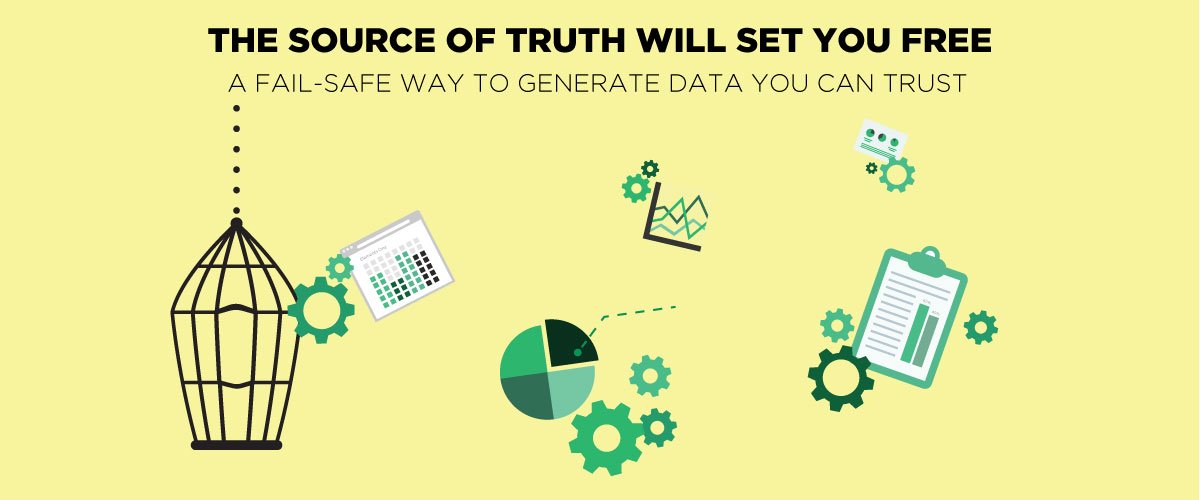Every business needs a guiding light. As a digital marketer, that light is the data guiding your marketing initiatives. If that light isn’t clear among all parties, the inconsistent spread of vital information can be your downfall. How can you avoid this potential disaster? The source of truth.
What is the source of truth?
The “source of truth” is a progressive term used for establishing an analytics platform that companies can turn to and trust as honest data. It’s used to measure success across all marketing channels and prevent dirty data from muddying your marketing strategy.
Understanding that decisions must be based off accurate data isn’t a new concept. But when five executives approach you with five sets of conflicting data, you have a problem — and the source of truth will set you free.

Why find a source of truth?
Establishing a source of truth eliminates confusion among departments and sets everyone on a clear pathway to success. When you utilize multiple marketing channels, those channels need to provide clean and consistent data so all parties can make strategic decisions that won’t put your business in a vulnerable position.
You might think that comparing data from platforms like Google Adwords and Analytics will give you the same data but that’s not always the case. Without a source of truth, each platform provides different values, causing inconsistent data. For example, the default attribution model for AdWords is last click, meaning, the credit for the sale goes to the last-clicked ad and corresponding keyword. In AdWords, that means credit is always given to Paid Search.

Analytics tells a different story. The standard attribution model in Analytics is last non-direct click, which means it will distribute credit based on the last interaction that wasn’t a direct visit to the site. If a shopper clicks an ad, then makes a purchase after an organic click, Analytics will give the sale to organic. Conversely, AdWords will take full credit because it was on the sales path.
You can see how a company working towards one goal from two completely different data sets can be problematic. Establishing a source of truth is the solution keeping your marketing goals aligned with clean data from any department at any given time. Here’s how to do it right.
What are the key components to a reliable source of truth?
- Establish Source of Truth
Find an analytics platform you can trust that matches your internal systems within a percentage of error. The platform you choose should be something you can benchmark your different marketing channels in. Our favorite platform to use when establishing a source of truth is Google Analytics. As a marketing-focused platform, it houses all of your data under one roof and provides advanced insight designed to drive results. It doesn’t hurt that it’s free, too. - Analytics that Allows Segmentation
Ensure the analytics platform you choose allows your marketing team to get a granular analysis of the data. This brings an understanding of your entire marketing puzzle, as well as its individual pieces. Segment your data and compare analytics with internal data to make sure the truth is in fact, the truth. If your analytics shows a $1,000 dollar sale, but the business’ bank account says otherwise — you have a problem. - Proper Tagging of Channels
Tag all marketing channels appropriately with a naming convention that allows segmentation and granular insight. If using Google Analytics, keep in mind that it’s limited by what data you send it. If you don’t feed Analytics all the information on your marketing channels, it’s not going to be used to its maximum capacity. Pair Analytics with the Google Tag Manager for an efficient and accurate way to keep your channels in check.

How can you trust the source of truth?
Instill trust in your source by making sure credit is going to the correct place. In Analytics, if Paypal is taking credit for sending you revenue, investigate referral exclusions. When a shopper makes a purchase on your site and is sent to Paypal (or a third-party payment processor), Analytics will count it as a referral and trigger a new session, resulting in inaccurate data of referral sites that contribute to revenue. Any third-party payment processor should be added to your exclusion list to avoid skewed data and an untrustworthy source of truth.
How to unleash my business’ full potential?
While it’s imperative to crunch numbers and make data-driven decisions, there’s high value in basic marketing principles that have stood the challenge of time. The power of traditional tactics like word-of-mouth and strong branding are still in play.
We’re not robots. We don’t operate entirely off of a sheet. When picking apart the data within your source of truth, also consider the human element needed to push your marketing further. Get the most out of your clean data by using it to influence new, creative ways to reach your audience.
Unleash the true power your business holds with the source of truth.





